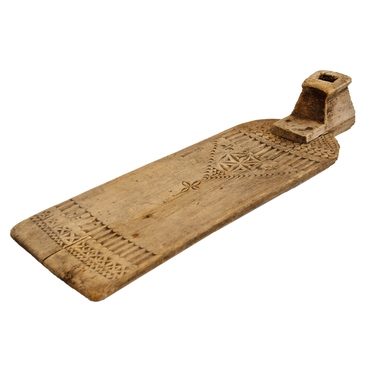This base of a distaff was made in the village of Krapivka, Lukoyanov District, Nizhny Novgorod Province, at the end of the 19th century and the first half of the 20th century. It was donated to the museum by Vladimir Martyanov, a postgraduate student of the Mordovian Research and Development Institute of Language, Literature, History and Ethnography. While working on his PhD thesis “Mordovian carved wood” in 1966 — 1969 he made expedition trips to the Nizhny Novgorod Region. A part of his collection, which included a variety of household items, became part of the museum.
The linden base is a board of rectangular shape with rounded edges to the foot, on which spinners sat while working. The entire surface of the board is covered with a geometric ornament, made in the chip-carving technique. The base, in which the vertical part of the distaff was fixed, is called “kopilok”. Its sides are also covered with a carved ornament. There are traces of brown paint on the carving.
The base is a part of a compound distaff, which was used to make threads of wool or vegetable fibers. Ancient distaffs were made of the stembase of a tree, which is a part of the trunk near the roots, and a section of the root served as a stand. Later there were compound spinners made of a board for sitting (base) and a comb with flax or wool.
People in countryside started spinning in the fall, when the field work ended and the evenings became longer. They kept spinning until Maslenitsa. Girls gathered in one house with distaffs and spindles and sang songs at work. They learned to spin from the age of 9 or 10.
The mass production of bases dates back to the second half of the 18th century, when the demand for hemp, yarn and canvas increased. In the Mordovian villages of Nizhny Novgorod province local craftsmen adopted the shape of the base from their Russian neighbors, but decorated it in accordance with their own traditions.
Chip-carving was popular among the Mordovians. This technique has been known since ancient times, but because of the short lifespan of the material, few samples have survived, the earliest of which can be dated to the end of the 18th century. Chip-carving were applied on dowry chests, weaving looms, bases of spinners, and other utensils.
The linden base is a board of rectangular shape with rounded edges to the foot, on which spinners sat while working. The entire surface of the board is covered with a geometric ornament, made in the chip-carving technique. The base, in which the vertical part of the distaff was fixed, is called “kopilok”. Its sides are also covered with a carved ornament. There are traces of brown paint on the carving.
The base is a part of a compound distaff, which was used to make threads of wool or vegetable fibers. Ancient distaffs were made of the stembase of a tree, which is a part of the trunk near the roots, and a section of the root served as a stand. Later there were compound spinners made of a board for sitting (base) and a comb with flax or wool.
People in countryside started spinning in the fall, when the field work ended and the evenings became longer. They kept spinning until Maslenitsa. Girls gathered in one house with distaffs and spindles and sang songs at work. They learned to spin from the age of 9 or 10.
The mass production of bases dates back to the second half of the 18th century, when the demand for hemp, yarn and canvas increased. In the Mordovian villages of Nizhny Novgorod province local craftsmen adopted the shape of the base from their Russian neighbors, but decorated it in accordance with their own traditions.
Chip-carving was popular among the Mordovians. This technique has been known since ancient times, but because of the short lifespan of the material, few samples have survived, the earliest of which can be dated to the end of the 18th century. Chip-carving were applied on dowry chests, weaving looms, bases of spinners, and other utensils.



